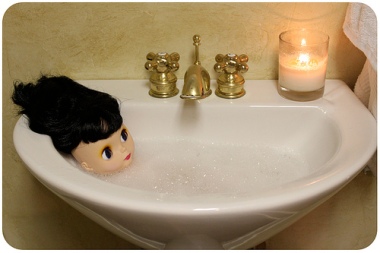Thanks to Julia, Lauren and Jenn for the good discussion this morning. With the unforeseeable demise of our coffee shop, we moved to the outdoor Dunkin’ Donuts populated with students, sunshine and the radio. Hopefully next time we can secure a place with less distractions.
 I guess it makes sense in a way to be talking about deliciousness and kitsch in the Dunkin’ Donuts. I am so glad to have Lauren and Jenn join in on the discussion because it brings multiple perspectives and I believe our text to be related to all of our artworks. I am a little sad to have finished the discussion of Harris’ book. I really love this text and I think that it is very influential to me. I enjoyed our discussion of bathing today as related to Harris’ chapter on cleanness. The sexuality of the bath as a preparation for sexual acts in old advertising transforms into the bath as a place of escape from the hectic world of the modern woman. “You deserve it!” “Calgon, Take me away!”
I guess it makes sense in a way to be talking about deliciousness and kitsch in the Dunkin’ Donuts. I am so glad to have Lauren and Jenn join in on the discussion because it brings multiple perspectives and I believe our text to be related to all of our artworks. I am a little sad to have finished the discussion of Harris’ book. I really love this text and I think that it is very influential to me. I enjoyed our discussion of bathing today as related to Harris’ chapter on cleanness. The sexuality of the bath as a preparation for sexual acts in old advertising transforms into the bath as a place of escape from the hectic world of the modern woman. “You deserve it!” “Calgon, Take me away!”
 The trend in advertising to acknowledge the distrust of the consumer is something that we discussed through the example of the Dove commercials now circulating the claim of showcasing real beauty. We talked about the dual ad for Dove and Wal-Mart that uses the “Ears hang low”song which lead into the interesting topic of the real or authentic. From there we got into a discussion of modernism versus relational aesthetics. All in all I think it was a good ending for our discussion of Harris’ book. I think that the ideas and aesthetics in this book will stick with me. I know that I will return to it and relate it to future readings. We have decided to take a break next week and then return to discuss texts by Adorno and Greenberg.
The trend in advertising to acknowledge the distrust of the consumer is something that we discussed through the example of the Dove commercials now circulating the claim of showcasing real beauty. We talked about the dual ad for Dove and Wal-Mart that uses the “Ears hang low”song which lead into the interesting topic of the real or authentic. From there we got into a discussion of modernism versus relational aesthetics. All in all I think it was a good ending for our discussion of Harris’ book. I think that the ideas and aesthetics in this book will stick with me. I know that I will return to it and relate it to future readings. We have decided to take a break next week and then return to discuss texts by Adorno and Greenberg.
